Numerical Design and Optimization of High Performance Langasite and Hetero-Acoustic Layer-Based Surface Acoustic Wave Device
Abstract
1. Introduction
2. Structural Design of LGS Based HAL SAW Device
2.1. Simulation Methods
2.1.1. COM Model
2.1.2. The Extraction of COM Model Parameters
2.2. Optimizing the Layer Number for LGS Based HAL SAW Device
2.3. The Selection of Intermediate-Layer Material
2.4. Electrode Thickness Optimization and Performance Comparison Between Conventional and HAL Structure SAW Devices
3. Conclusions
Author Contributions
Funding
Data Availability Statement
Conflicts of Interest
References
- Li, Y.; Lin, H.; Lin, J.; Zhou, C.; Luo, A.; Yang, J.; Zhang, J.; Hong, Z.; Hou, X.; Xiao, P.; et al. Thermally Stable Piezoelectric Sensors for Quantitative Pressure Sensing Based on Linear Piezoelectric Zinc Oxide Thin Films. Mater. Des. 2023, 235, 112466. [Google Scholar] [CrossRef]
- Hassan, A.; Savaria, Y.; Sawan, M. GaN Integration Technology, an Ideal Candidate for High-Temperature Applications: A Review. IEEE Access 2018, 6, 78790–78802. [Google Scholar] [CrossRef]
- Youbi, U.; Hage-Ali, S.; Zhang, Q.; Yang, Y.; M’jahed, H.; Aubert, T.; Elmazria, O. High-Q Wireless SAW Sensors Based on AlN/Sapphire Bilayer Structure, Operating at 2.45 GHz Range for High-Temperature Applications. IEEE Sens. Lett. 2024, 8, 1–4. [Google Scholar] [CrossRef]
- Yang, Z.; Wang, F.; Nie, W.; Han, X.; Guo, X.; Shan, X.; Lin, X.; Dun, H.; Sun, Z.; Xie, Y.; et al. Surface Acoustic Wave Temperature Sensor Based on Pt/AlN/4 H-SiC Structure for High-Temperature Environments. Sens. Actuators A 2023, 357, 114379. [Google Scholar] [CrossRef]
- Aubert, T.; Elmazria, O.; Assouar, B.; Blampain, E.; Hamdan, A.; Genève, D.; Weber, S. Investigations on AlN/Sapphire Piezoelectric Bilayer Structure for High-Temperature SAW Applications. IEEE Trans. Ultrason. Ferroelectr. Freq. Control 2012, 59, 999–1005. [Google Scholar] [CrossRef]
- Suhak, Y.; Fritze, H.; Sotnikov, A.; Schmidt, H.; Johnson, W.L. High-Temperature Electromechanical Loss in Piezoelectric Langasite and Catangasite Crystals. J. Appl. Phys. 2021, 130, 085102. [Google Scholar] [CrossRef]
- Li, L.; Peng, B. Temperature-Dependent Characteristics of Surface Acoustic Wave Resonators Deposited on (0°, 138.5°, ψ) Langasite Cuts. IEEE Sens. J. 2019, 19, 1388–1391. [Google Scholar] [CrossRef]
- Nagmani, A.K.; Behera, B. A Review on High Temperature Piezoelectric Crystal La3Ga5SiO14 for Sensor Applications. IEEE Trans. Ultrason. Ferroelectr. Freq. Control 2022, 69, 918–931. [Google Scholar] [CrossRef] [PubMed]
- Naghdi, M.; Zhang, H.; Sreedharan, S.V.; Ju, S.; Desai, M.H. A New FEM-Based Approach on the Modeling of Stress-Induced Velocity Shift of Piezoelectric Surface Acoustic Wave Resonators. Ultrasonics 2025, 148, 107521. [Google Scholar] [CrossRef] [PubMed]
- Pasupuleti, K.S.; Pham, T.M.T.; Abraham, B.M.; Thomas, A.M.; Vidyasagar, D.; Bak, N.-H.; Kampara, R.K.; Yoon, S.-G.; Kim, Y.-H.; Kim, M.-D. Room Temperature Ultrasensitive Ppb-Level H2S SAW Gas Sensor Based on Hybrid CuO@V2C MXene van Der Waals Heterostructure. Adv. Compos Hybrid Mater. 2025, 8, 132. [Google Scholar] [CrossRef]
- Xue, T.; Xu, F.; Tan, Q.; Yan, X.; Liang, X. LGS-Based SAW Sensor That Can Measure Pressure up to 1000 °C. Sens. Actuators A 2022, 334, 113315. [Google Scholar] [CrossRef]
- Zhou, X.; Tan, Q.; Liang, X.; Lin, B.; Guo, T.; Gan, Y. Novel Multilayer SAW Temperature Sensor for Ultra-High Temperature Environments. Micromachines 2021, 12, 643. [Google Scholar] [CrossRef] [PubMed]
- Zhang, H.; Mu, D.; Zhang, Z.; Zhang, J.; Sun, J.; Jin, H. Surface Acoustic Wave Sensors for Wireless Temperature Measurements above 1200 Degree Celsius. Sensors 2024, 24, 4945. [Google Scholar] [CrossRef]
- Naumenko, N.; Nicolay, P.; Elmazria, O. Towards an Optimal Architecture of High Temperature LGS-Based SAW Sensors. In Proceedings of the 2016 IEEE International Ultrasonics Symposium (IUS), Tours, France, 18–21 September 2016; pp. 1–4. [Google Scholar]
- Shan, Q.; Ke, H.; Shi, Y.; Hao, W.; Luo, W.; Han, T. Suppression of Spurious Modes on LGS with Euler Angle of (0°, 22°, 30°). In Proceedings of the 2020 IEEE International Ultrasonics Symposium (IUS), Las Vegas, NV, USA, 7–11 September 2020; pp. 1–4. [Google Scholar]
- Takai, T.; Iwamoto, H.; Takamine, Y.; Yamazaki, H.; Fuyutsume, T.; Kyoya, H.; Nakao, T.; Kando, H.; Hiramoto, M.; Toi, T.; et al. Incredible High Performance SAW Resonator on Novel Multi-Layerd Substrate. In Proceedings of the 2016 IEEE International Ultrasonics Symposium (IUS), Tours, France, 18–21 September 2016; pp. 1–4. [Google Scholar]
- Takai, T.; Iwamoto, H.; Takamine, Y.; Fuyutsume, T.; Nakao, T.; Hiramoto, M.; Toi, T.; Koshino, M.I.H.P. SAW Technology and Its Application to Microacoustic Components (Invited). In Proceedings of the 2017 IEEE International Ultrasonics Symposium (IUS), Washington, DC, USA, 6–9 September 2017; pp. 1–8. [Google Scholar]
- Hsu, T.-H.; Tseng, K.-J.; Li, M.-H. Large Coupling Acoustic Wave Resonators Based on LiNbO3/SiO2/Si Functional Substrate. IEEE Electron. Device Lett. 2020, 41, 1825–1828. [Google Scholar] [CrossRef]
- Huo, Z.; Liu, T.; Li, T.; Wu, X.; Hu, J.; Zhang, X.; Zhong, H. A High Q and High Coupling SAW Resonator on Multilayer Polymide Substrate. In Proceedings of the 2021 IEEE International Conference on Advances in Electrical Engineering and Computer Applications (AEECA), Dalian, China, 27–28 August 2021; pp. 849–853. [Google Scholar]
- Li, L.; Zhang, Q.; Li, B.; Yang, Y.; Tian, Y.; Li, H. A New Method for Temperature Dependent COM Parameters Extraction and Its Application to Simulation of SAW Devices. J. Phys. Conf. Ser. 2024, 2822, 012170. [Google Scholar] [CrossRef]
- Plessky, V.; Koskela, J. Coupling-of-Modes Analysis of Saw Devices. Int. J. High Speed Electron. 2000, 10, 867–947. [Google Scholar] [CrossRef]
- Hao, W.; Liu, J.; Liang, Y. Mass Sensitivity Optimization of a Surface Acoustic Wave Sensor Incorporating a Resonator Configuration. Sensors 2016, 16, 562. [Google Scholar] [CrossRef] [PubMed]
- Jiang, G.; Shuai, Y.; Wei, Z.; Yao, J.; Luo, W.; Pan, X.; Wu, C.; Zhang, W. Modeling for High-Frequency Spurious Responses in Incredible High-Performance Surface Acoustic Wave Devices. Micromachines 2024, 15, 134. [Google Scholar] [CrossRef]
- Sun, X.; Ma, R.; Zhou, S.; Shao, X.; Cheng, J.; Lin, D.; Wang, W.; Liu, W. Fast, Accurate and Full Extraction of Coupling-of-Modes Parameters by Finite Element Method. Crystals 2022, 12, 706. [Google Scholar] [CrossRef]
- Koskela, J.; Plessky, V.P.; Salomaa, M.M. COM Parameter Extraction from Computer Experiments with Harmonic Admittance of a Periodic Array of Electrodes. In Proceedings of the 1997 IEEE Ultrasonics Symposium Proceedings. An International Symposium (Cat. No.97CH36118), Toronto, ON, Canada, 5–8 October 1997; Volume 1, pp. 119–122. [Google Scholar]
- Ntagwirumugara, E.; Gryba, T.; Zhang, V.Y.; Dogheche, E.; Lefebvre, J.-E. Analysis of Frequency Response of IDT/ZnO/Si SAW Filter Using the Coupling of Modes Model. IEEE Trans. Ultrason. Ferroelectr. Freq. Control 2007, 54, 2011–2015. [Google Scholar] [CrossRef]
- Wu, J.; Zhang, S.; Zhang, L.; Zhou, H.; Zheng, P.; Yao, H.; Li, Z.; Huang, K.; Wu, T.; Ou, X. Exploring Low-Loss Surface Acoustic Wave Devices on Heterogeneous Substrates. IEEE Trans. Ultrason. Ferroelectr. Freq. Control 2022, 69, 2579–2584. [Google Scholar] [CrossRef] [PubMed]
- Takai, T.; Iwamoto, H.; Takamine, Y.; Yamazaki, H.; Fuyutsume, T.; Kyoya, H.; Nakao, T.; Kando, H.; Hiramoto, M.; Toi, T.; et al. High-Performance SAW Resonator on New Multilayered Substrate Using LiTaO3 Crystal. IEEE Trans. Ultrason. Ferroelectr. Freq. Control 2017, 64, 1382–1389. [Google Scholar] [CrossRef] [PubMed]
- Zhang, J.; Mu, D.; Gao, F.; Xuan, W.; Jin, H.; Chen, J.; Dong, S.; Luo, J. Surface Acoustic Wave Bound State in the Continuum for 1200 °C High Temperature Sensing. J. Micromech. Microeng. 2024, 34, 075003. [Google Scholar] [CrossRef]
- Zhang, N.; Lin, C.-M.; Rao, Y.; Senesky, D.; Pisano, A. 4H-SiC PN Diode for Extreme Environment Temperature Sensing Applications. Sens. Extrem. Harsh Environ. 2014, 9113, 24–29. [Google Scholar]
- Levinshtein, M.; Rumyantsev, S.; Shur, M. Properties of Advanced Semiconductor Materials: GaN, AlN, InN, BN, SiC, SiGe. Wiley-Interscience: Hoboken, NJ, USA, 2001. [Google Scholar]
- Perevislov, S.N. Determination of the Temperature Coefficient of Linear Expansion of Materials Based on Silicon Carbide. Refract. Ind. Ceram. 2021, 61, 665–670. [Google Scholar] [CrossRef]
- Roshchupkin, D.; Kovalev, D. Coefficients of Thermal Expansion in La3Ga5SiO14 and Ca3TaGa3Si2O14 Crystals. Materials 2023, 16, 4470. [Google Scholar] [CrossRef] [PubMed]
- Hsu, T.-H.; Lee, Z.-Q.; Tsai, C.-H.; Lin, C.-C.; Yu, Y.-C.; Li, M.-H. Harnessing Acoustic Dispersions in YX-LN/SiO2/Si SH-SAW Resonators for Electromechanical Coupling Optimization and Rayleigh Mode Suppression. IEEE Trans. Ultrason. Ferroelectr. Freq. Control 2023, 70, 1786–1793. [Google Scholar] [CrossRef] [PubMed]
- Zhang, B.; Han, T.; Tang, G.; Zhang, Q.; Omori, T.; Hashimoto, K. Influence of Coupling with Shear Horizontal Surface Acoustic Wave on Lateral Propagation of Rayleigh Surface Acoustic Wave on 128°YX-LiNbO3. Jpn. J. Appl. Phys. 2017, 56, 07JD02. [Google Scholar] [CrossRef]
- Huang, Y.; Bao, J.; Li, X.; Zhang, B.; Tang, G.; Omori, T.; Hashimoto, K.-Y. Influence of Coupling Between Rayleigh and SH SAWs on Rotated $Y$ -Cut LiNbO 3 to Their Propagations. IEEE Trans. Ultrason. Ferroelectr. Freq. Control 2018, 65, 1905–1913. [Google Scholar] [CrossRef]
- Baba, A.; Searfass, C.T.; Tittmann, B.R. High Temperature Ultrasonic Transducer up to 1000 °C Using Lithium Niobate Single Crystal. Appl. Phys. Lett. 2010, 97, 232901. [Google Scholar] [CrossRef]
- Bernstein, B.T. Elastic Constants of Synthetic Sapphire at 27 °C. J. Appl. Phys. 1963, 34, 169–172. [Google Scholar] [CrossRef]
- Deshpande, V.; Rahangdale, V. Study of PbTiO3-Based Glass Ceramics Containing SiO2. ISRN Ceram. 2012, 2012, 823903. [Google Scholar] [CrossRef]
- Tsou, C.; Huang, Y.-S.; Li, H.-C.; Lai, T.-H. Determination of Thermal Expansion Coefficient of Thermal Oxide. Sens. Mater. 2005, 17, 441–451. [Google Scholar]
- Kosinski, J.A.; Gualtieri, J.G.; Ballato, A. Thermal Expansion of Alpha Quartz. In Proceedings of the Proceedings of the 45th Annual Symposium on Frequency Control 1991, Los Angeles, CA, USA, 29–31 May 1991; pp. 22–28. [Google Scholar]
- Chilla, E.; Flannery, C.M.; Fröhlich, H.-J.; Straube, U. Elastic Properties of Langasite-Type Crystals Determined by Bulk and Surface Acoustic Waves. J. Appl. Phys. 2001, 90, 6084–6091. [Google Scholar] [CrossRef]
- Pei, G.; Ma, B.; Ye, T.; Zhang, Z.; Zhao, K.; Deng, J.; Ramakrishna, S.; Luo, J. Single Crystal-Single Crystal Bonding of Langasite Exhibited High Strength of 23.28 MPa. J. Mater. Sci. Technol. 2023, 160, 139–147. [Google Scholar] [CrossRef]
- Wulfmeier, H.; Feder, R.; Zhao, L.; Fritze, H. Epitaxial Piezoelectric Langasite Thin Films for High-Temperature Application. MRS Adv. 2019, 4, 523–529. [Google Scholar] [CrossRef]
- Aubert, T.; Nicolay, P.; Sarry, F. Thermoelastic Effects in Pt IDTs. Impact on the Behavior of High-Temperature LGS-Based SAW Devices. In Proceedings of the 2013 IEEE International Ultrasonics Symposium (IUS), Prague, Czech Republic, 21–25 July 2013; pp. 259–262. [Google Scholar]
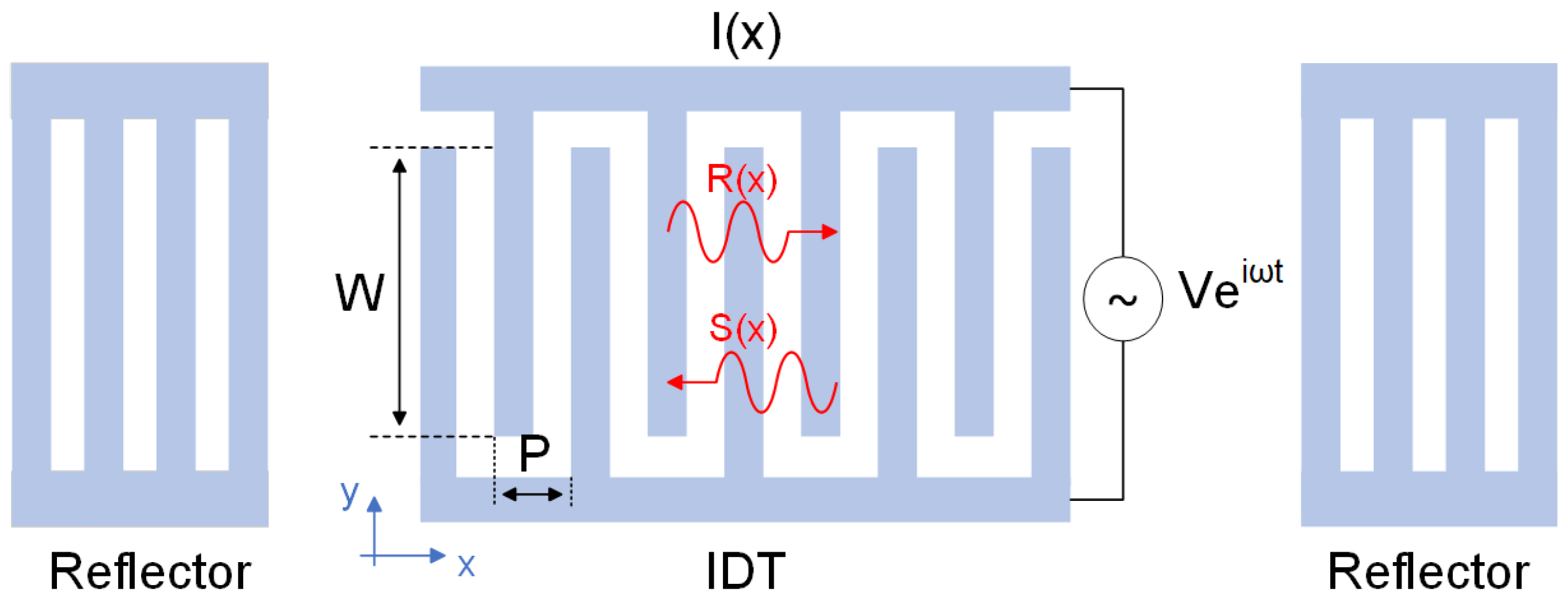
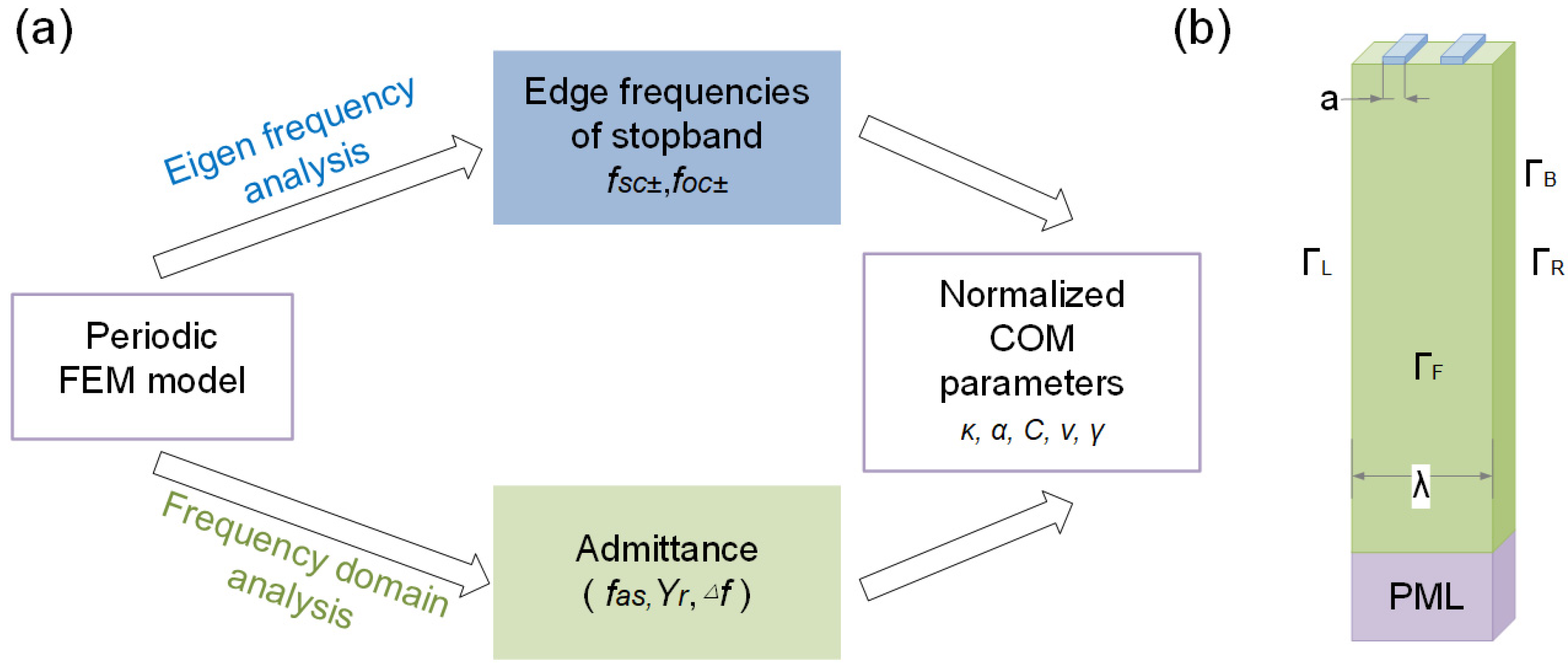
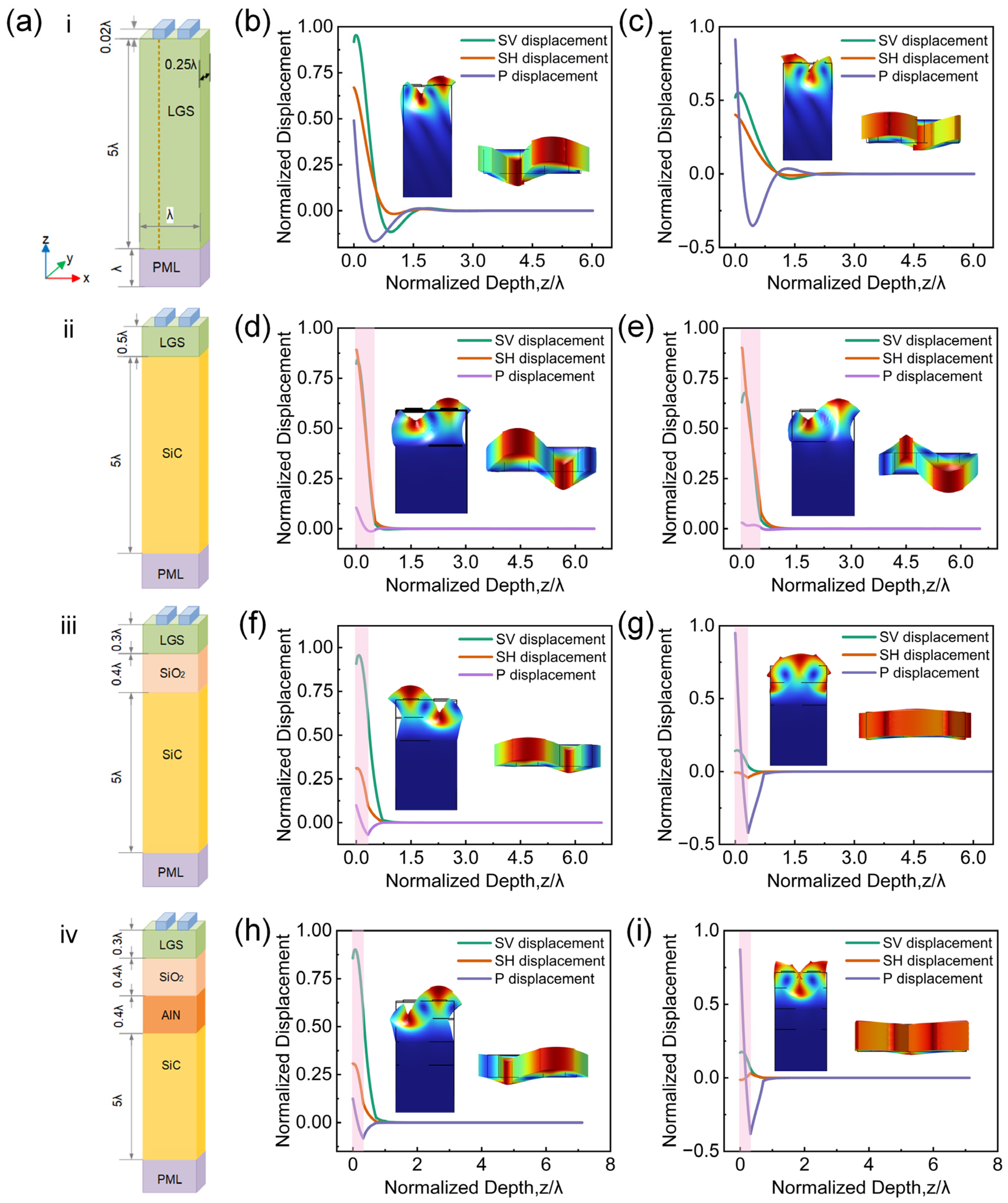
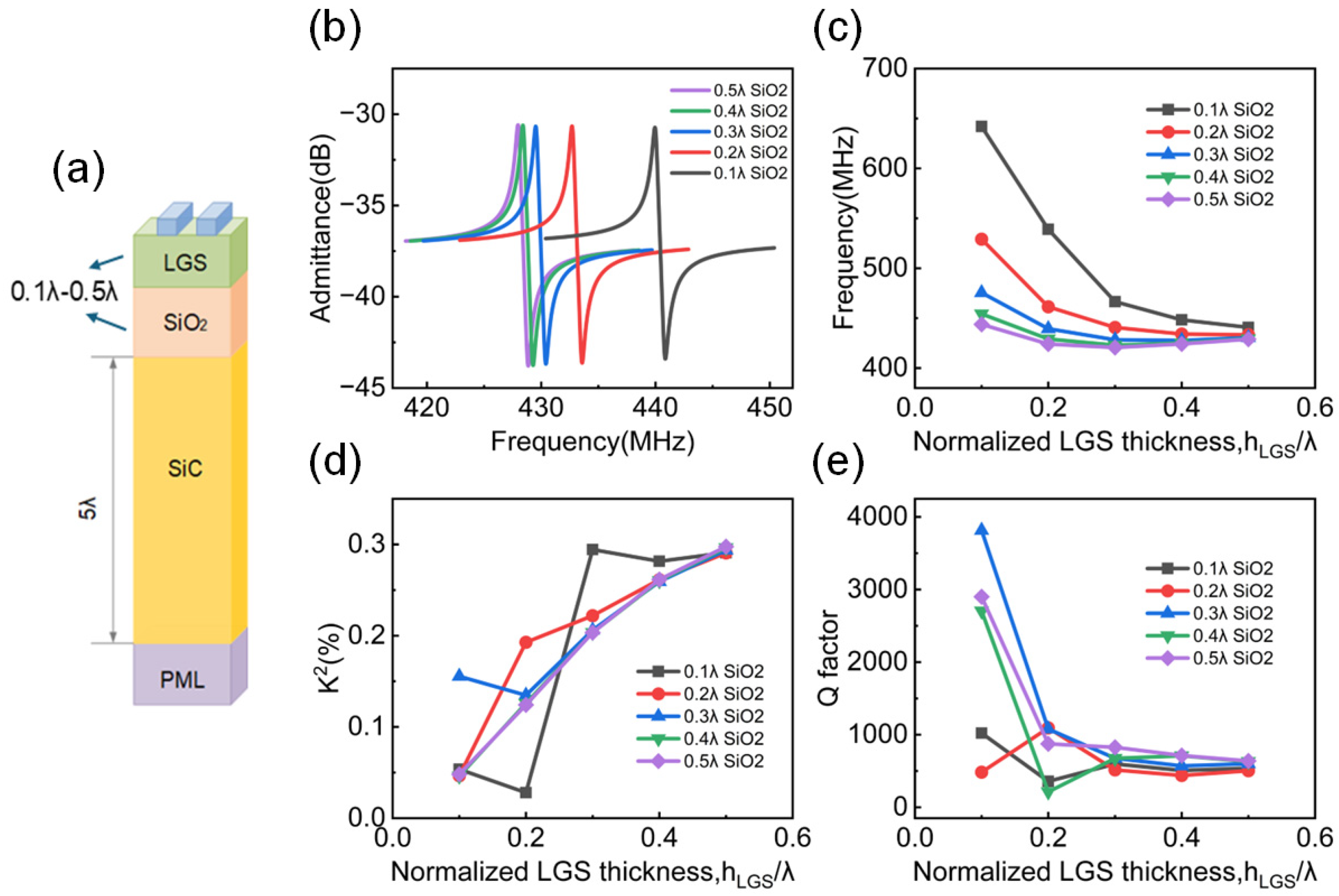

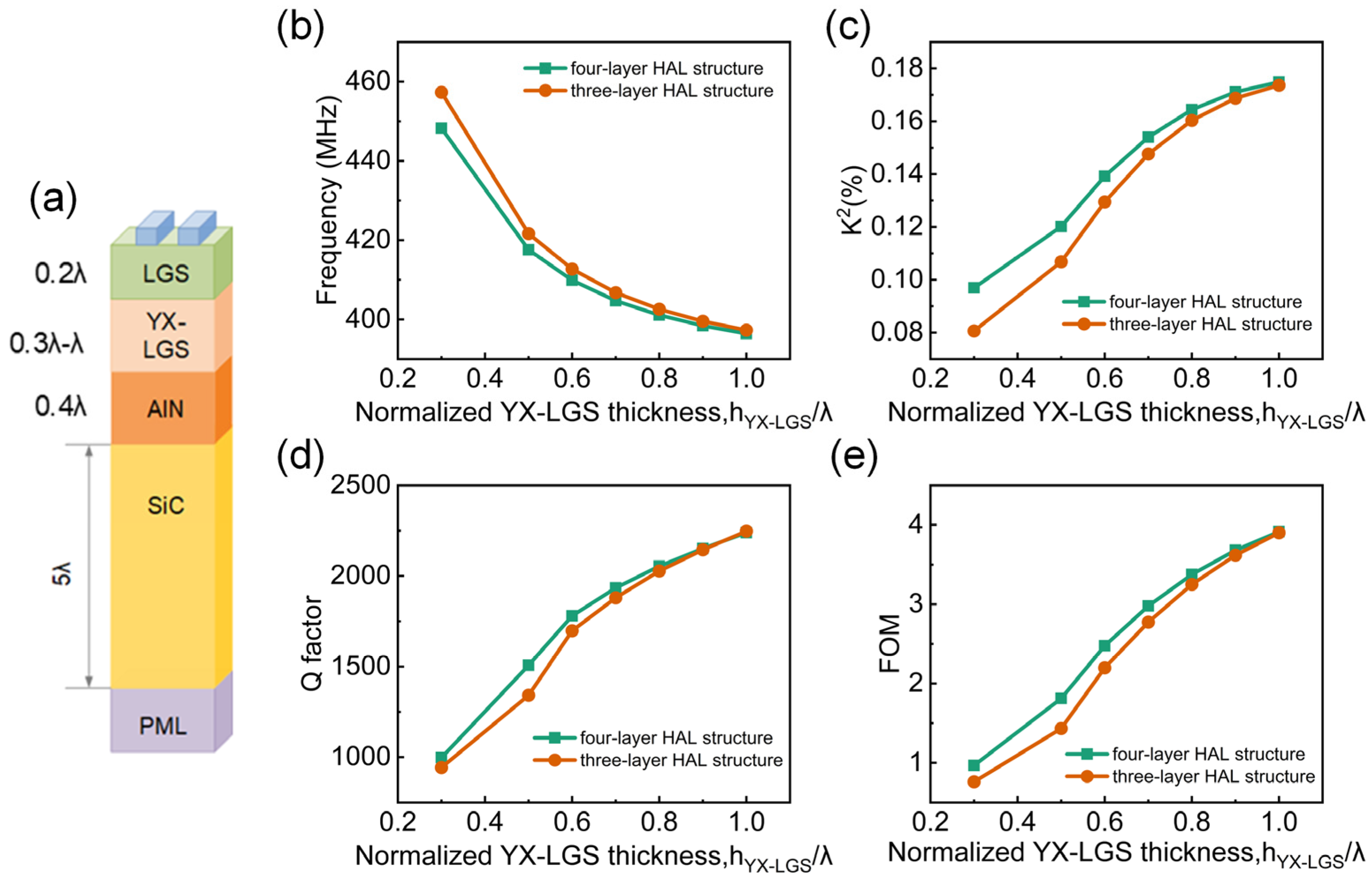
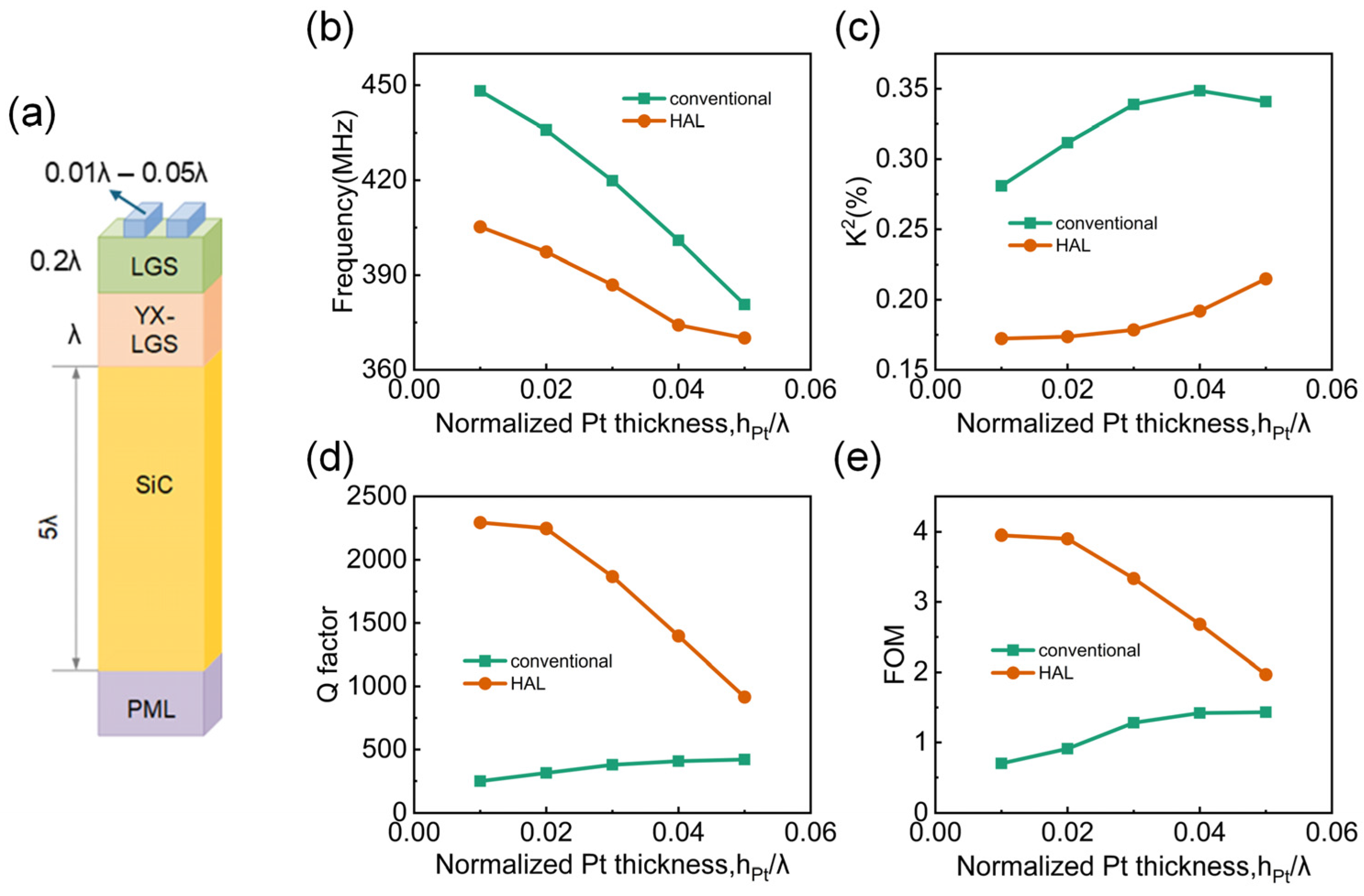
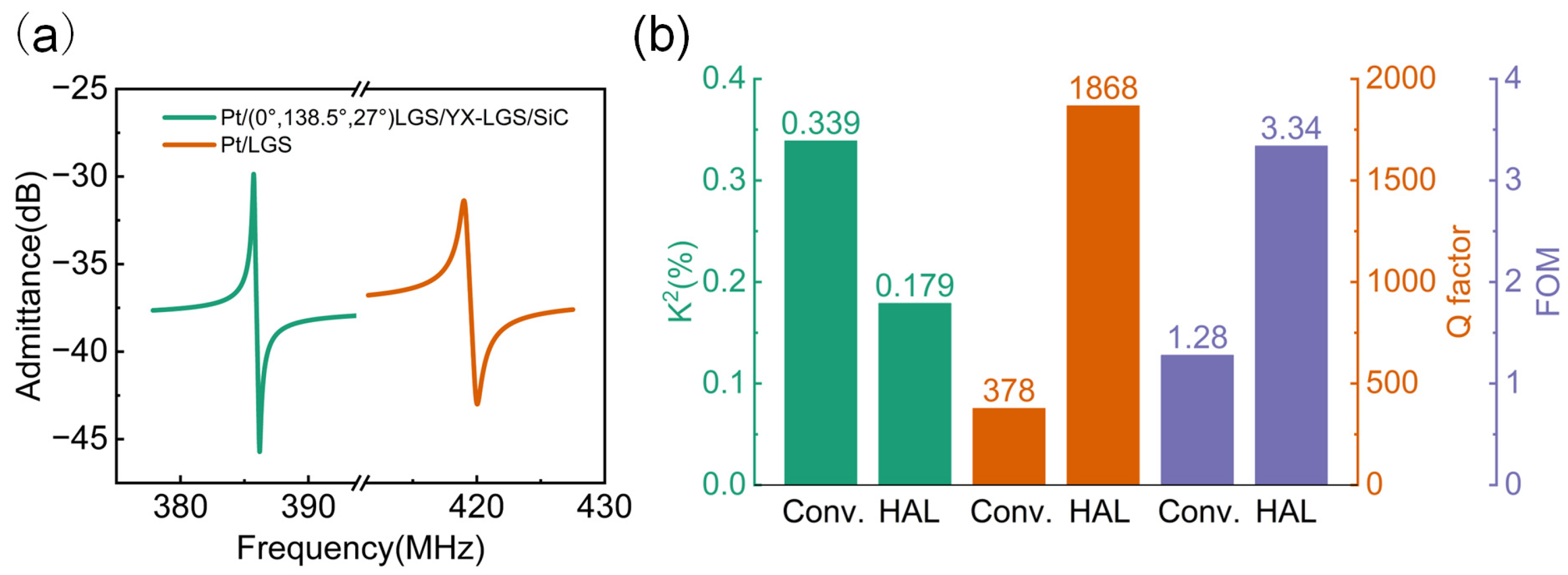
Disclaimer/Publisher’s Note: The statements, opinions and data contained in all publications are solely those of the individual author(s) and contributor(s) and not of MDPI and/or the editor(s). MDPI and/or the editor(s) disclaim responsibility for any injury to people or property resulting from any ideas, methods, instructions or products referred to in the content. |
© 2025 by the authors. Licensee MDPI, Basel, Switzerland. This article is an open access article distributed under the terms and conditions of the Creative Commons Attribution (CC BY) license (https://creativecommons.org/licenses/by/4.0/).
Share and Cite
Deng, M.; Chen, J.; Zhang, J.; Xie, W.; Jin, H.; Xuan, W.; Dong, S.; Luo, J. Numerical Design and Optimization of High Performance Langasite and Hetero-Acoustic Layer-Based Surface Acoustic Wave Device. Micromachines 2025, 16, 166. https://doi.org/10.3390/mi16020166
Deng M, Chen J, Zhang J, Xie W, Jin H, Xuan W, Dong S, Luo J. Numerical Design and Optimization of High Performance Langasite and Hetero-Acoustic Layer-Based Surface Acoustic Wave Device. Micromachines. 2025; 16(2):166. https://doi.org/10.3390/mi16020166
Chicago/Turabian StyleDeng, Minglong, Jinkai Chen, Jikai Zhang, Weilun Xie, Hao Jin, Weipeng Xuan, Shurong Dong, and Jikui Luo. 2025. "Numerical Design and Optimization of High Performance Langasite and Hetero-Acoustic Layer-Based Surface Acoustic Wave Device" Micromachines 16, no. 2: 166. https://doi.org/10.3390/mi16020166
APA StyleDeng, M., Chen, J., Zhang, J., Xie, W., Jin, H., Xuan, W., Dong, S., & Luo, J. (2025). Numerical Design and Optimization of High Performance Langasite and Hetero-Acoustic Layer-Based Surface Acoustic Wave Device. Micromachines, 16(2), 166. https://doi.org/10.3390/mi16020166










